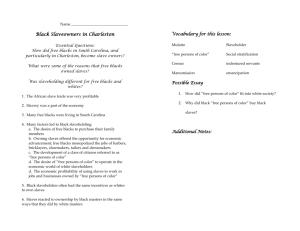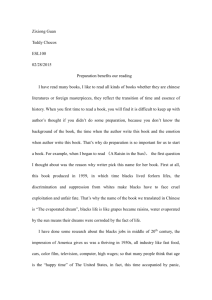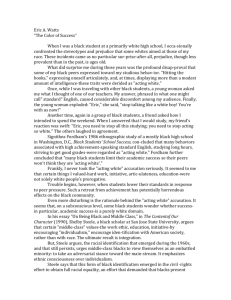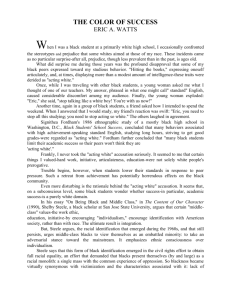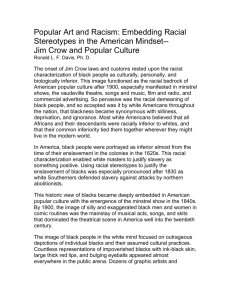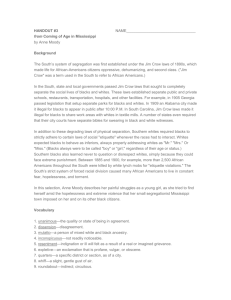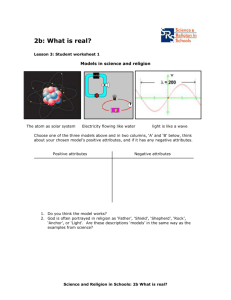10/3/09 BLIND SPOT: A SELF-CRITIQUE Paul M. Sniderman Paper
advertisement
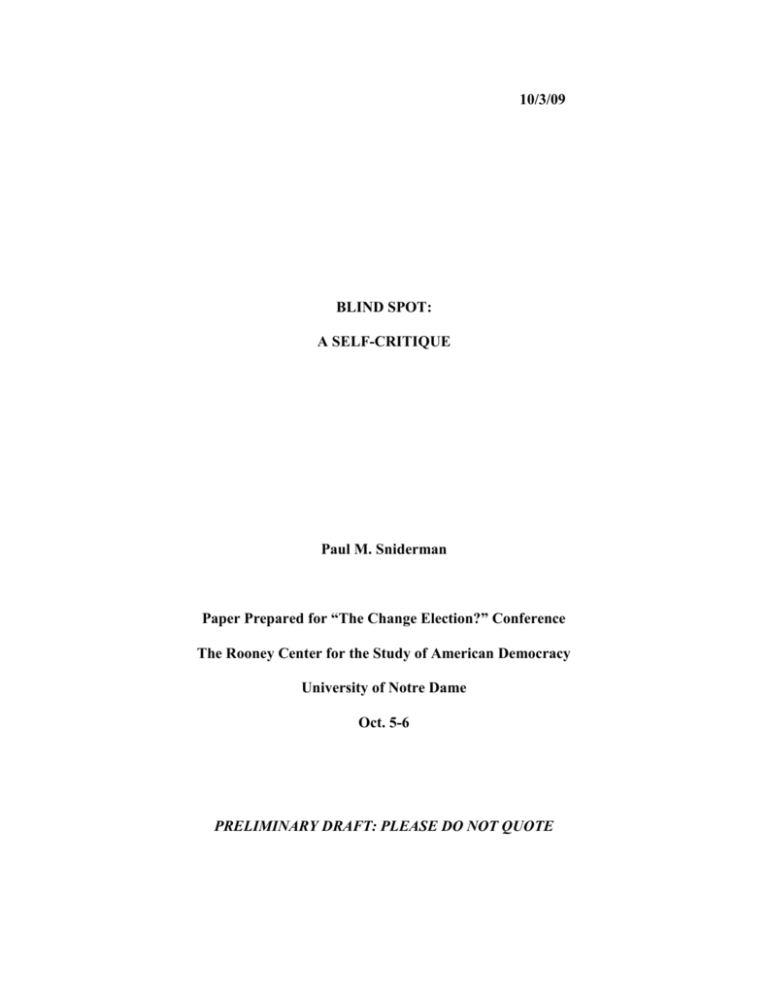
10/3/09 BLIND SPOT: A SELF-CRITIQUE Paul M. Sniderman Paper Prepared for “The Change Election?” Conference The Rooney Center for the Study of American Democracy University of Notre Dame Oct. 5-6 PRELIMINARY DRAFT: PLEASE DO NOT QUOTE BLIND SPOT: A SELF-CRITIQUE Research reviews are a science staple, and the more critical, often the more helpful. Bringing into focus issues of validity, bringing forward alternative explanations, bringing out shortfalls in reasoning is an integral part of the struggle for knowledge. But the template is always the same: one researcher calling attention to the limitations of the work of another researcher. I want to turn things about and put on the public record a blind spot in my thinking about race and American politics.1 Self-criticism can be a form of self-praise, I recognize. If you did not believe that you had gotten a good many things right, why would you suppose that any one might be interested in what you think that you got wrong? On the other hand, every claim to discovery is presumptuous. What else does a claim of discovery amount to other than a claim that you have seen something that no one before you has seen. I have wrestled with this issue. Two considerations made up my mind. I believe that what is at issue is important to many and I know that the way I can best convey it is to make plain what I failed to see. Perhaps I might add a third consideration. In a field of research known for the sharpness of its critical exchanges, there is much to recommend a revised version of the Golden Rule and do unto oneself what one has done unto others. In speaking of the blind spot in our thinking, we do not mean to imply that this is the only point on which we have not got things right. We do mean to be clear that it is the biggest thing that we have failed to see, we believe. 1 My starting point is the classic definition of prejudice. Whatever differences researchers have on prejudice should be measured, all agree that this is what should be measured. This is a textbook example, I will argue, of how one can miss an important part of a puzzle by getting the most important part of it right. I. The Prejudice Paradigm Prejudice has been variously, some would say promiscuously, defined. A protracted, and sometimes politicized, debate gas followed, not surprisingly. My view? At the operational level, this criticism is surely right. But at the conceptual level, it is off target. The specific words vary from one definition to another, to be sure, and some place more emphasis on one aspect, others more on another. But to our knowledge all definitions agree that “prejudice consists in attributions about groups or members of groups, by virtue of their membership in the group, that are disparaging and hostile, false, or at least without warrant, and rigidly held.”2 All the components in this definition are right, I believe. Yet, only one is useful all the same. We can agree that some stereotypical evaluations of groups are false. What we cannot agree on is that all evaluations of groups that are said to be stereotypes are false. More worryingly, although stereotyping is a way to getting things wrong, stereotyping is a necessary cognitive strategy for getting things right.3 For that matter, stereotypes go in and out of fashion. Should we really conclude that overt racial prejudice has disappeared because large numbers of white Americans no longer say that Sniderman, Peri, de Figuerirido, and Piazza 2000 p. 19. See also Fig. 2.1. Definitions of Prejudice p.17. 2 3 For a classic statement, see Hamilton, Stroessner, and Driscoll 1994. black Americans are biologically inferior? No more than drawing the same conclusion because few whites say “blacks have rhythm.” And, to put all our cards on the table, can we determine whether beliefs are being “rigidly held?” In a laboratory experiment possibly, but not in a public opinion interview. In the context of an interview, we can achieve only the most elementary level of measurement – ordinal. It follows that we cannot say that one person is prejudiced and another is not, let alone that one is twice as prejudiced as the other. What does this leave to say to say that prejudice means? Here is what I came to believe what is the heart of the matter. “The more consistently a person attributes negative characteristics, or alternatively, declines to attribute positive characteristics to a group, the more prejudiced he or she is.”4 Indicators of prejudice are contestable. The job of a measure of prejudice is not. Its purpose is to rank-order individuals from most to least prejudiced. Figure 1 provides a graphic illustration: the more prejudiced a person, the higher his rank; the less intolerant, the lower his rank. Insert Figure 1 About Here Or so I thought. So my colleagues and I designed a measure for the study of prejudice in America that has been the template in all our studies since.5 Respondents were asked whether a series of adjectives were good descriptions of most blacks. On a scale from from 0 to 10, 10 was a VERY GOOD description of most blacks; 0 a VERY INACCURATE description of most blacks 6 Nine adjectives are positive, five negative. The ratio of positive to negative descriptors was no accident. The negative adjectives 4 Sniderman, Peri et al., p. 25, italics in original. 5 IDENTIFY The format has changed; and – tellingly, the ratio of positive to negative descriptors, as I shall make plain. 6 were nasty – e.g., aggressive or violent, lazy; the positive ones milquetoast – e.g. “friendly,” “smart with practical, everyday things.” Asking whether most blacks had discreditable characteristics could provoke interview break-offs, we feared. And one derogatory characterization asked after another, the experience would be seen as biased. So we sandwiched the negative descriptors in-between the positive ones; hence the far larger number of positive than negative descriptors. But our focus was the derogatory ones, the insulting ones. So we built and tested our measure of prejudice. Which is to say, we analyzed to a fare thee well relations among the five negative descriptors to each other and to a host of other variables. Time passed. The GSS and NES introduced an alternative format for the measurement of prejudice. 7 Respondents evaluate a group (whites or blacks on a randomized basis) on a series of traits; then the other group on the same series of traits; with prejudice being defined as a more unfavorable rating of blacks than of whites.8 The GSS/NES procedure is thus different than ours. The conception of prejudice is the same as ours, though. The more negative the response to blacks, the more prejudiced whites are.9 Positive feelings are not part of the story.10 The two measures are not independent. The NES is an abbreviated form of the GSS. 7 8 The order of groups is randomized. We compared and contrasted our Index of Prejudice with GSS and NES measures of prejudice. The coefficients were virtually identical in every test. So our conceptual thinking and research practice became cemented. 9 Only a handful of whites rate blacks more favorably than blacks; and rating the two same is to interpreted an absence of negative feelings, not an equality of respect. 10 II. Obama and Attitudes toward Blacks Many, perhaps most, students of American public opinion and electoral behavior are searching for an explanation of the election of the first African American President of the United States. The question, for me, is not how Obama came to be elected, as important as this question is. It is instead what light Obama’s election throws on understanding the larger issue of America’s struggle with the issue of race. It had never entered my head that an African American would win the Presidency of the United States in my lifetime. Without having done systematic research, I would tell you that it had not entered anyone else’s. That Obama could compete and win the nomination was astonishment to us all. After the fact many explanations are on offer. Which are right I do not know. What I did know, as soon as Obama won the Democratic nomination, was this. Notwithstanding all the work that my colleagues and I had done over the last twenty-five years, we had missed something integral to the American experience. This awareness that we had missed something took me aback. Being misled by imperfect measures; making a mistake in estimation; failing to take account of alternative line of analysis; above all, all, being over-ready to accept as true what we had come to believe was true – those were the ways of going wrong that I worried about. Failing altogether to see an integral part of the American struggle over racial equality – that possibility had never had crossed my mind. Yet it was obvious that we had. The fact that an African American had won nomination for President of the United States was proof. But what was it that we had missed seeing? And why had we missed it? There must be a positive factor or factors that we had overlooked, I reasoned. The most obvious explanation that Obama was doing well was his personal attributes. This explanation must be true in some degree, and quite possibly in a large degree, considering how extraordinary his talents are. But however impressive Obama’s talents and personality, they are by definition an idiosyncratic factor; which is to say, not one that could be anticipated. In themselves, they could not throw light on the question of interest to me – the meaning of race in the contemporary American experience. There was another possibility, though. Perhaps it was not entirely a matter of Obama doing well in spite of being black. Perhaps he was doing well partly because of being black. On reflection, this idea did not seem self-evidently absurd. The fight against racism and racial inequality has been central to American politics at least since the mid 1950s. Over the last half century, white Americans have marched hand-in-hand with black Americans in civil rights protests; sponsored, funded, and organized registration drives of black voters; participated in an array of inter-racial community organizations; supported an affirmative policy agenda to assure equality of opportunity and, albeit with more division, to achieve equality of condition. And what should this – admittedly fragmentary – aspect of the American experience suggest? That substantial numbers of white Americans have positive attitudes toward black Americans. I do not mean merely that they are racially liberal in a political sense, though I think this is the factor that other research programs missed. Not do I mean that they are moved by pity or sympathy on the grounds that blacks have historically been ill-treated.11 I mean quite simply that they think well of blacks Americans. 11 For an imaginative proposal along these lines, see Schuman and Harding 1963 . But so far as this is so, and it was only a supposition that it was so, then the established paradigm of prejudice had to be re-thought. Figure 1 summarized this paradigm. It showed Americans rank-ordered on a dimension of feelings toward black Americans from most prejudiced to least prejudiced. But if some significant number of Americans think well of black Americans, a different conception of attitudes toward blacks is necessary. Figure 2 sets out the most obvious alternative. As before, Americans are rank-ordered along an evaluative continuum of attitudes toward black Americans. Unlike before, the evaluative dimension is bipolar. The closer a person is to the right pole of the continuum, the more negative his feelings toward blacks. The closer to the left pole, the more positive his feelings toward blacks. Insert Figure 2 About Here This way of thinking about evaluative attitudes toward minorities has much to recommend it, parsimony above all. It may prove to be the most useful conception in the end. It cannot be the one used in the beginning, though. There are several difficulties. I will mention one. If the objective is to gauge the role of good will in determining reactions on matters of race in addition to that of ill will, everything hangs on the location of the “neutral” point on the evaluative continuum of attitudes toward blacks (Figure 2). The further to the left one locates, the larger the role of ill will, other things equal; the further to the right, the larger the role of good will. Moreover, an attitude of neutrality toward blacks does not make psychological sense. What would it mean to say that a person has neither positive nor negative feelings toward blacks, yet has an attitude toward them? The way to get this new line of research off the ground was ahead-on assault, I reasoned. Measure positive and negative attitudes toward blacks separately. Then put them head-to-head in accounting for racial choices in politics. What should be true if the positive characterizations that white Americans express about black Americans in an interview are meaningful? As negative feelings induce opposition to policies to assist blacks, positive ones should induce support. But, one may reasonably ask, does this not make having esteem for blacks a synonym for having a liberal outlook on politics. After all, most of the policies that are designed to help blacks are liberal policies? Thinking well of blacks cannot be just a synonym for being a political liberal. Some differentiation between the two is necessary. So we have two expectations. On the one hand, thinking well of black Americans should predispose white Americans to support policies to assist them as a general matter. On the other hand, it should not automatically induce support for them. In addition, my concern is to probe the meaning of the American experience, not the election of Obama. It is at least arguable that the emergence of a person with the extraordinary abilities of Obama will induce people to respond more positively toward blacks than they otherwise would. It is necessary therefore to examine attitudes toward blacks before the emergence of Obama. I turn therefore to the National Race and Politics Study (NRAP), conducted in 1991, and the battery of positive and negative evaluations towards “most blacks” that I have described. Responses to the five negative adjectives were combined to build an Index of Prejudice. Responses to the nine positive adjectives were combined to build an Index of Esteem. Policy positions on an array of racial policies were measured, typically via randomized experiments. In these experiments, the wording of questions was varied to make salient diverse features of the policy or problem context. Table 1 shows the unstandardized regression coefficients for the measures of positive and negative attitudes towards blacks.12 The results are not quite what I expected, I should confess. I had supposed that positive attitudes would matter, but negative ones would count for much more. In fact, the Esteem coefficients are as large as the Prejudice coefficients – government helping blacks get more jobs – or larger – plans to increase opportunities for blacks to buy homes in white suburbs, welfare, and university quotas. Heavy breathing about the larger coefficients for Esteem should be postponed, though, if only because the estimates manifestly are not fully specified. Insert Table 1 About Here Two other aspect of Table 1 deserve comment, one because it is puzzling, the other because it is telling. The puzzling result is that positive attitudes toward blacks go along with increased support for affirmative action in higher education, but in general do not go along with support for quotas in employment. Ex post, one can argue that those who have positive attitudes toward blacks see more opportunities for education as increasing opportunities for blacks, while believing that blacks and whites should be judged on an equal basis when it comes to getting hired. Perhaps this is right, perhaps not, I simply cannot decide on the basis of the evidence at hand. The more telling aspect of the results is the conditional activation of positive attitudes toward blacks. Consider the comparative magnitude of the Esteem coefficients across policy choices. The coefficients for Esteem are markedly larger on the issue of 12 All variables have scaled from 0 to 1. increasing opportunities for blacks to live in middle class suburbs than for other policies. This is specially so when the proposal is backed by religious or business groups or the weight of the government. Two of them begin with the digit 6. The issue of eliminating discrimination in housing is the closest we have to a classic civil rights issue of the 1950’s and 60’s. That positive attitudes matter most for an issue of equal treatment – a prototypical example of assuring equal opportunity -- suggests that what activates them are considerations of fairness. This suggestion is quite indirect, I recognize. However, Table 1 provides more direct evidence consistent with it. Consider the relative magnitudes of the Esteem coefficients for the Job Quotas Experiment.13 In this Experiment, respondents are asked whether they support or oppose racial hiring quotas for large companies. In one condition, no justification for quotas is given. In the second condition, a justification is given: a finding that blacks are under-represented in the companies’ work force. In the third condition a justification also is given but a quite different one: a finding that these companies have discriminated against blacks. In the first condition positive attitudes are of no consequence, indeed, the coefficient is not distinguishable from zero. In the second condition, the coefficient is zero. It is striking, then, that positive attitudes are activated in the third condition where the issue of fair treatment but not in the first and second. As against coefficients indistinguishable from zero in the first two conditions, the Esteem coefficient is -.42 in the discrimination condition. Again, this is consistent with the suggestion that considerations of fairness are especially relevant for those with positive attitudes toward blacks. But this should be treated as only a suggestion, we must say. This experiment was designed by Professor Laura Stoker to bring out the role of principles in policy choices. See Stoker 1902. 13 The principal conclusion is that positive attitudes toward blacks have as large an impact on choices on racial policies as negative attitudes toward them, and often larger.14 But all that this proves, some may object, is that there is an association between positive attitudes and policy attitudes. Is there evidence that thinking well of blacks affects actual behavior? The most recent presidential election provides a serendipitous opportunity to respond to this question. Table 2 shows the results of a regression of vote choice on our two measures – Esteem and Prejudice. Repeating again the caution that we looking only at two variables, and using one measure that has been put into action for the first time, we still think the result is striking. Positive attitudes towards blacks predict vote choice as well as negative attitudes towards them. Insert Table 2 About Here I take the results to this point as consistent with the hypothesis that it is not a matter merely of many white Americans lacking negative attitudes. But I do not wish to play with words. So I now want to explore a quite different angle. III. An Attributional Perspective My objective is to bring out, from a quite different perspective, my blind spot. Replication adds confidence, and this is why we have tested the results from our first data set with an analysis of a second data set. I want to raise the bar, though.. I do not want merely to show that one arrives at the same conclusion by building the same measures and redoing the same analysis on an independent data sets. I want to expose our blind spot by following an entirely different line of analysis and employing quite different We use causal language “impact” or our sentences would go endlessly on. Obviously, no causal inference is intended in this bivariate set-up. 14 measures. I owe this line of analysis entirely to Gomez and Wilson’s innovative development of attributional theory.15 They develop a general taxonomy of explanatory modes – general in the sense of applying across policy domains; explanatory in the sense of specifying alternative modes of explanation of public problems. In particular, they distinguish between two types of explanation. One type focuses on explanatory factors immediately tied to the choice or behavior to be explained. The other type focuses on explanatory factors at a further remove in the causal chain. In the idiom of attributional theory, a person’s behavior can be a function of her attributes or, alternatively, of her circumstances. Among other policy domains, Gomez and Wilson apply their theory to racial politics. Their focal point is the measure of Racial Resentment (or Symbolic Racism, as it sometimes is called). This measure occupies a central position in research on race and American political attitudes and behavior. It has been subjected to closer scrutiny – supportive as well as critical -- than any other measure in this research domain, we would hazard. But one of its oddities has been discovered only recently – that it couples two different factors. Analyzing the 1986 and 2000 NES studies, Gomez and Wilson demonstrate that a two-factor model provides the best fit. 16 Drawing on their general theoretical perspective to draw on, Gomez and Wilson treat the two factors as We want to acknowledge an intellectual debt. We do not mean to imply that Gomez and Wilson would necessarily agree with the implications we have drawn from their work. On the contrary, they put these variables to a quite different and original use developing a theory of heterogeneous attributions. 15 In an earlier study, Tarman and Sears (2005) estimated an array of factorial models of the component items of the Racial Resentment Index. Their analysis showed that the best fit is a two-factor model. They contend that the measure can nonetheless be treated as unidimensional, for all practical purposes 16 representing distinct forms of causal explanations. One represents a proximal explanation, attributing the fact that blacks are less well off than whites to attributes of blacks themselves. Defining this mode as Individualist, they measure it by the combination of responses to two items: 1). “Irish, Italians, Jews, and many other minorities overcame prejudice and worked their way up. Blacks should do the same without any special favors.”i 2). “It’s really a matter of some people not trying hard enough; if blacks would only try harder they could be just as well off as whites.” The second causal mode attributes racial inequality, not to the failures of blacks, but to historical burden that they have had to bear. This mode Gomez and Wilson define as Structuralist, and operationally assess it as the combination of responses to these two items: 1). “Over the past few years, blacks have gotten less than they deserve.” 2). “Generations of slavery and discrimination have created conditions that make it difficult for blacks to work their way out of the lower class.” In this framework of causal attributions, the key to understanding policy choices is whether a person attributes the problems of another person to the person himself (a proximal explanation) or to the circumstances or of the group (a distal explanation. Those favoring proximal explanations of racial inequality should attach responsibility to blacks, and holding them responsible for their problems, oppose government policies to assist them. By contrast, those favoring distal explanations, should see blacks as having still to combat obstacles rooted in the structure and history of American history, and therefore should tend to support government policies to help them. Drawing on the 2004 NES, Table 3 presents a series of regressions of policy choices on the alternative explanatory modes. The policy themselves cover a considerable range, from government assurance of fair treatment in hiring to affirmative action, to welfare, to government job programs for blacks. In addition, we include two measures that are not overtly racial – a measure of commitment to equality as a value17 and federal assistance for the poor. Insert Table 3 About Here Consider first the explicitly racial policy choices. Both structuralist and individualist orientations are equally, and independently, predictive across the range of policies, with one exception: job programs for backs. Otherwise, on assurance of fair treatment, preferential hiring, and welfare, their coefficients are interchangeable. In view of this mirror image performance, it is reasonable to ask whether the two modes are measuring different things or different sides of the same coin. On this score, the results for the last two columns are suggestive. The Structuralist measure is a markedly better predictor of positions on the issue of federal assistance for the poor. Assistance for the poor is a surrogate for black, one might object. This objection, however, is undercut by the results for the Equality Index. This version of the Equality Index was deliberately purged of associations with race. And the Structuralist factor is a significantly better predictor than the Individualist factor of Equality scores. This pattern of results is sufficiently suggestive that it deserves to be tested on an independent data set. Table 4 accordingly sets out comparable estimates for policy This is the Egalitarian Index, originally developed by Feldman 1902, and subsequently revised by Sears, Henry, and Kosterman 2000 to purge it off a racial component. 17 measures in the 2000 NES. The similarity of the results is striking, apart from the coefficients being systematically smaller. On the one hand, on explicitly racial issues, Individualist and Structuralist measures make contributions of similar magnitude. That pattern holds for government assurance of fair treatment of jobs, preferential hiring, welfare, and government assistance for blacks. On the other hand for policies and political values that are not explicitly racial, the coefficients for thinking in terms of people’s circumstances are significant while the coefficients for thinking in terms of their failings are not significant. This pattern holds for the Equality Index and federal assistance to the poor. The patterns for 2000 are those identical to those for 2004. These results are not dispositive, we want to emphasize. But they do lend support to the hypothesis that structuralist and individualist attributions about racial inequality are not mirror images of the same thing. They share much in common. All the same, they capture discernibly different orientations. IV. Repris I have spoken about positive and negative attitudes toward blacks, as though they are two unrelated things. Also, I have presented the evidence in a way that suggests positive attitudes are roughly as important as positive ones. These results are preliminary. I have to do a better job of measurement and think through a fuller specification. All the same, I believe that these results constitute reasons for believing that it is not only whites Americans thinking ill of black Americans that matters. Their thinking well of them counts, too. Try as I might, I cannot find in this claim my work. One reason is that framing the issue as though they are two separate and opposing forces, one positive and the other negative, is not quite the right way to think of the problem. As a theoretical matter, it is implausible to suppose that people keep independent evalutive score cards of minorities. Imagine that there are two persons, A and B. A has a highly positive attitude toward blacks in many respects. B has a highly negative attitude toward blacks in these respects. How likely is it that A is as likely as B to have a highly negative attitude toward blacks in still other respects – or B as likely as A to have highly positive one in these other respects? Yes, the measures of positive and negative attitudes toward blacks are only weakly related in the 1991 NRAP study (r=--.23). But taking our lead from Green and his colleagues’ (1994, 1993) studies of noncorrelated random measurement error, we determined in an earlier study that this appearance of independence is an illusion. Correcting for measurement error, we determined the two are markedly correlated.18 For the record, we stopped short of drawing the conclusion of unidimensionality. “Although it would be difficult to argue from these results that positive and negative stereotypes are completely bipolar, it is clear that the two sets of attitudes are closely related,”19 – that was as far as we went. That was a conclusion that we reached two years after completing our study, Reaching Beyond Race. I cannot claim that this conclusion sunk in my mind. The Interfactor Correlation for Confirmatory Factor Analysis of the Stereotype Items with Nonrandom Measurement Error taken into account – which includes three additional items for identification – is .74. See Levine, Carmines and Sniderman 1999 Table 4 p. 380 18 19 Ibid p. 381. In a subsequent study of multiculturalism in The Netherlands, I omitted all but one of the positive adjectives.20 What marks, then, would I give our research program? On the positive side of the ledger, I believe that we got some important things right. First, the clash over racial policy over the last generation has been primarily a conflict between competing political orientations. Second, although the imprint of racial prejudice racism remains clearly discernible, colors reactions to issues of race, but is no longer the driver of political positions on in issues of race. Third, we showed before Obama emerged that it is possible to reach beyond race and build a winning coalition by approaching issues of inequality and need in morally universalistic terms rather than racially particularistic ones.21 On the negative side of the ledger, we missed the fact that the conflict over race is not only propelled by whites who think of ill of blacks. There is an opposing force of whites who think well of them. This is not an easy mistake for political scientists who observed the civil rights movement in the 1950’s and 60’s to explain away. Nor should it be read as a conclusion of triumphalism. The problems before us are immensely complex. It strains credulity to presume success on all fronts. And failure on some may open the door to a racial backlash, we acknowledge. On the other hand, the conclusion of Ways of Life argues that tolerance is an affirmative, positive force, not merely the absence of negative feelings. 20 The results and argument in Ch. 4 Reaching Beyond Race is the only research on race in American politics logically consistent with the election of an African American as President of the United States. For that matter, Obama’s campaign was a textbook illustration of approaching issues in morally universalistic terms rather than racially particularlistic ones. 21 Bibliography Gomez, Brad T., and J. Matthew Wilson 2006. “Rethinking Symbolic Racism: Evidence of Attribution Bias,” Journal of Politics 68: 611-25. Green, Donald Philip and Jack Citrin 1994. “Measurement Error and the Structure of Attitudes: Are Positive and Negative Judgment Opposites?” American Journal of Political Science 38: 256-81. Green, Donald Philip, Susan L. Goldman, and Peter Salovey 1993. “Measurement Error Masks Bipolariaty in Affect Ratings,” Journal of Personality and Social Psychology 64: 1029-41. Hamilton, David L., Steven J. Stroessner, and Denise M. Driscoll 1994. “Social Cognition and the Study of Stereotyping.” In Social Cognition: Impact on Social Psychology, ed. Patricia G. Devine, David L. Hamilton and Thomas M. Ostrom. New York: Academic Press. 292-323. Levine Jeffrey, Edward G. Carmines, and Paul M. Sniderman 1999 “The Empirical Dimensionality of Racial Stereotypes,” Public Opinion Quarterly 63: pp.371-384 Schuman, Howard and John Harding 1963 “Sympathetic Identification With the Underdog”, Public Opinion Quarterly 27: 230-241. Sears, David O., P. J. Henry, and Rick Kosterman 2000. “Egalitarian Values and Contemporary Racial Politics.” In Sears, David O., Jim Sidanius, and Lawrence Bobo (eds.) Racialized Politics, Chicago: University of Chicago Press. Sniderman, Paul M. and Edward H. Stiglitz. 2008. “Race and the Moral Character of the Modern American Experience.” The Forum: A Journal of Applied Research in Contemporary Politics, 6(4). Paul M. Sniderman and Louk Hagendoorn, 2007, When Ways of Life Collide, Princeton, N.J.: Princeton University Press. Paul M. Sniderman, Pierangelo Peri, Rui de Figuerido, and Thomas Piazza. 2000. The Outsider: Prejudice and Politics in Italy. Princeton, NJ: Princeton University Press. Tarman, C. & David. O. Sears. 2005 “The Conceptualization and Measurement of Symbolic Racism, The Journal of Politics, 67: 731-761. Table 1: Racial Policy Preference and Positive and Negative Attitudes Towards Blacks 1991 National Race and Election Study (Whites Only) Employment for Blacks Govt Should Govt Spend Should more Do More Esteem -.49 -.39 (.13) (.12) Prejudice .51 .39 (.09) (.10) *Unstandardized Coefficients Blacks Buy House White Suburbs Religious or Business Subsized Group Housing -.60 -.51 (.07) (.07) .37 .20 (.06) (.05) Govt program -.64 (.08) .27 (.06) Welfare Welfare -.42 (.07) .23 (.05) Job Quotas University Quotas Blacks underFinding Preference Neutral represented Discrimination Blacks -.12 .02 -.42 -.35 (.14) (.12) (.15) (.08) .55 .32 .18 .21 (.11) (.09) (.11) (.06) Extra Effort -.25 (.09) .11 (.07) Table 2: A Behavioral Test AP/Stanford (White Voters Only) N=1404 Vote for Obama Esteem .36 (.08) Prejudice .35 (.06) *Unstandardized Coefficients Table 3: Two Orientations to Racial Inequality NES 2004 (Whites Only) N=(764) Gov FairTreat Structuralist -.50 (.08) Individualist .53 (.08) *Unstandardized coefficients Pref Hire -.29 (.04) .26 (.04) Welfare -.24 (.05) .22 (.06) Gov Help Blacks .20 (.04) -.40 (.04) Equality .23 (.03) -.07 (.03) Fed Poor -.35 (.08) .10 (.08) Table 4: Two Orientations to Racial Inequality NES 2000 (Whites Only) N=(1,174) Gov FairTreat Structuralist -.44 (.06) Individualist .48 (.06) *Unstandardized Coefficient Pref Hire -.17 (.03) .15 (.03) Welfare -.16 (.04) .20 (.04) Gov Help Blacks -.30 (.03) .30 (.04) Equality .26 (.03) -.04 (.03) Fed Poor -.15 (.04) .06 (.04) Figure 1: Established Measurement Paradigm of Prejudice More Prejudice Less Prejudice Figure 2: Revised Measurement Paradigm of Prejudice Most Negative i Most Positive This symbolic racism item is also found in The Washington Post study and is used later in the paper to provide further validation of our claims.

